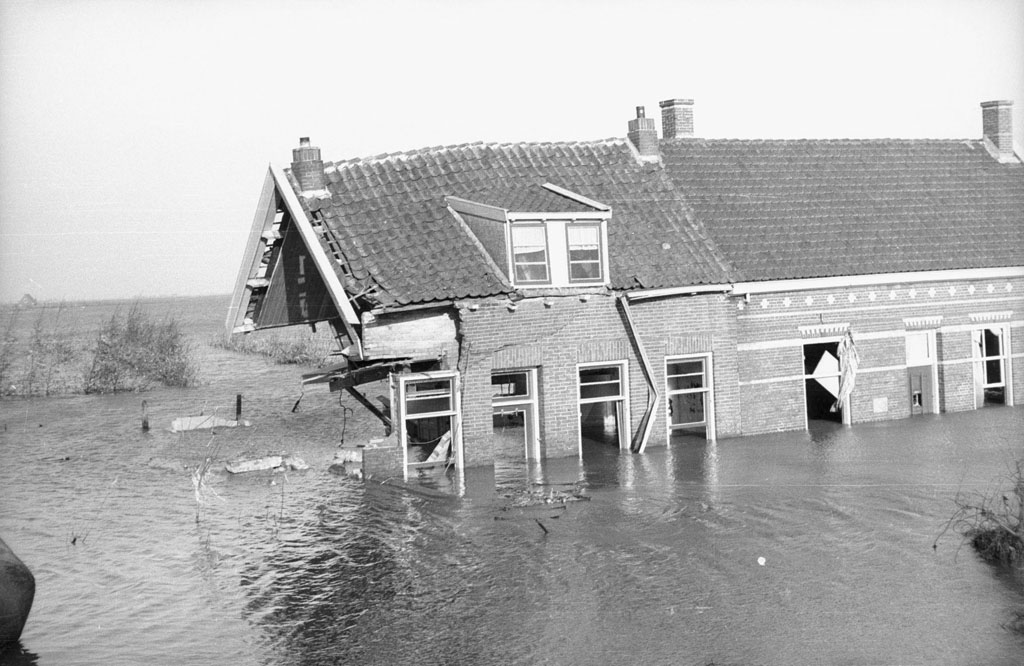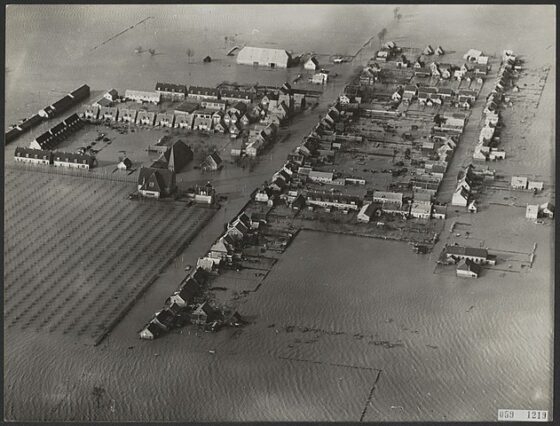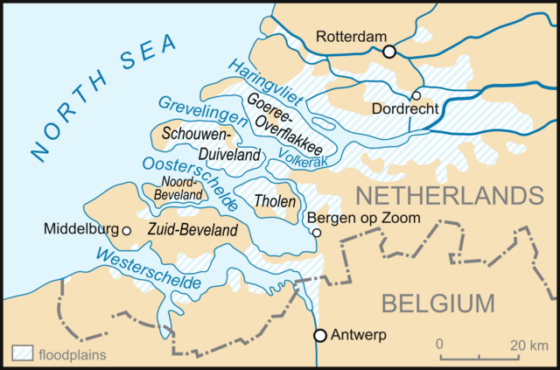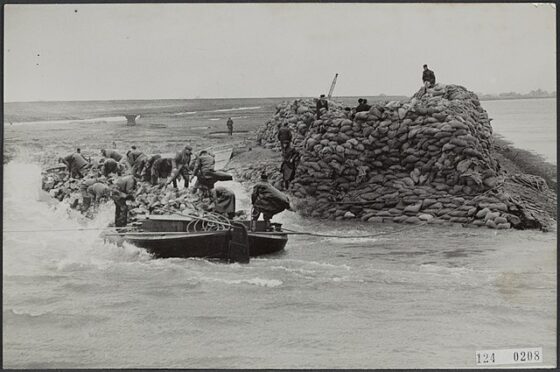Inburgering with Dutch News: key facts about the great flood of 1953

This week marks 70 years since a devastating storm wreaked havoc along much of the North Sea coastline. This is what you need to know about its terrible consequences for the Netherlands.
Lesson 36: the flood of 1953
What happened?
On 31 January, 1953 a storm that had been gathering south of Iceland wended its way via Scotland towards the Dutch coast, disastrously combining force gale winds and a spring tide.
The dykes broke in Zeeland, Zuid-Holland and Noord-Brabant late on a pitchblack Saturday night in what is known in Dutch history as the Watersnoodramp.
The flood came in two devastating waves on January 1 and February 1 and cost the lives of 1,836 people. A further 72,000 were evacuated. Some 47,000 cattle and 140,000 chickens and other poultry drowned, 43,000 houses were destroyed and 150,000 hectares of farmland were ruined by the salt water.
‘Then our raft broke and we all fell into the water. I heard our neighbour say goodbye to his family. I felt myself sink in between the bits of wood and other stuff. I thought: we’re all going to drown and in a little while we’ll see each other again in heaven,’ one eyewitness told Omroep Zeeland in 2018.
In today’s money the damage was estimated at €5.4 billion.

How it could happen?
It was 1953, not that long after the World War II. The Netherlands was busy shaping the wederopbouw, the post-war effort of getting the economy back on track and building new housing.
And that, unfortunately, did not include strengthening the dykes which had been in bad way and faced further neglect from budget cuts. That, combined with the very high winds and spring tide created, one might say, the perfect storm.
In addition, although there had been official warnings about the flood, none of the local radio stations broadcast at night and the message failed to get through in enough time to enable people to prepare. The problem was compounded by the disaster striking on a Saturday night, so many government and emergency offices in the affected area were not staffed.
What happened in other countries?
In the UK, 1,600 kilomtres of coastline was damaged, and water surging through the broken sea walls ruined 160,000 acres of agricultural land. Over 24,000 homes in the UK were seriously damaged and 40,000 were left homeless.
Fishing vessels surprised by the storm foundered, as did the ferry MV Princess Victoria which was sailing from Stranraer in Scotland to Larne in Nothern Ireland with 179 people on board, including a 51 crew. The life boat carrying the women and children capsized and all drowned. In total, the death toll in Britain was put at 307, with a further 224 lives lost at sea.
In Belgium some 15,000 hectares of agricultural land were destroyed and cities like Oostend, Antwerp, Dendermonde were flooded. Some 28 people died.

Not everyone was identified
Many people were buried without being identified, but thanks to a large-scale DNA project which was started in 2013 some are now being named. Some 80 people have now given DNA samples in the hope of identifying members of their family who perished in the flood.
The project is ongoing and relatives of people who disappeared in the flood can still give DNA samples.
The flood in film and literature
De Kleine Ark (the little ark) written by Jan de Hartog in the year of the watersnoodramp depicts the horrors of the flood through the eyes of two children who see the bloated bodies of people and animals float by from the small boat in which they and a number of animals manage to survive, The book was made into a film in the United States in 1972.
According to poet Ad Zuiderent, writing about the flood and its place in Dutch literature 50 years after the event, no one had ever written ‘a masterly novel’ about the event, although it does appear, often to great effect, in literary works.
Whether or not 1953 by Rik Launspach is that novel is up for discussion. The book was made into a film called The Storm, about a young unmarried woman whose baby is stolen as she is fleeing from the water. The scenario was 10 years in the making and the film finally premiered in 2009.
The aftermath
On November 1953, 7 months after the flood, the last dyke was repaired, on the Zeeland island of Schouwen-Duiveland. Meanwhile a massive international campaign to help the victims of the flood was mounted under the slogan ‘Beurzen open, dijken dicht’ (Open you wallets, close the dykes).

The disaster in Zeeland finally put coastal defense, which had been languishing at the bottom of the agenda for years, at the front of policy makers’ minds. A unique and ambitious project, the Deltawerken coastal defense system was started in 1953 and finished in 1997.
Recent developments
As time went on, engineers became aware that the focus on keeping the sea out altogether was detrimental to marine life, nature and the fishing industry. The decision was made to fit the Oosterschelde storm surge barrier with sluice doors which are open but can be closed in adverse weather conditions.
The Deltaworks will last a while yet, Delta commissioner Peter Glas commented at the commerations in 2018, but sea level rises projections have doubled from 20 to 40 centimetres a year and that may have consequences for the structures’ lifetime.
Other floods
There are two other major floods as well as that of January 31, 1953, which helped shape the appearance of the Netherlands today.
In 1170, the All Saints Flood hit large parts of the northern Netherlands and Holland, forming the islands of Wieringen and Texel and opening a sea channel from the North Sea into lake Flevo, creating the Zuiderzee. It also marked the beginning of Amsterdam, giving the fledgling village a way through to the sea.
The Christmas flood of 1717 was also the result of a northwesterly storm, which hit the coast area of the Netherlands, Germany and Scandinavia. In total, about 14,000 people drowned. It was the last large storm flood in the north of the Netherlands. Floodwaters reached the towns and cities of Groningen, Zwolle, Amsterdam and Haarlem, and some villages behind the sea dykes in Groningen province were washed away.
Where to find out more
If you would like to know more about the flood of 1953 you could visit the Watersnoodmuseum near Ouwerkerk in Zeeland. Footage of the aftermath of the disaster and eye witness accounts paint an impressive picture of the devastating events.
Thank you for donating to DutchNews.nl.
We could not provide the Dutch News service, and keep it free of charge, without the generous support of our readers. Your donations allow us to report on issues you tell us matter, and provide you with a summary of the most important Dutch news each day.
Make a donation